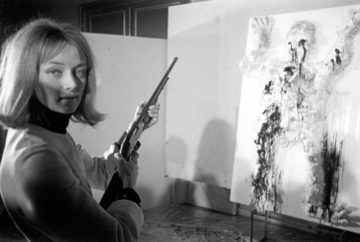Johanna Fateman at Artforum:
 Feminist is not a descriptor she embraced until late in life (she died in 2002 at the age of seventy-one). Mostly, it’s a label that has been bestowed upon her in attempts to contend with her quixotic ambition. Her resistance to the term, though, derived not from a real quarrel with its meaning so much as from some murky combination of misunderstanding, eccentricity, and calculation. Her personal brand of rebellion emerged before the advent of the women’s movement proper, in the pregnant pause between the publication of Simone de Beauvoir’s The Second Sex in 1949 (when she was an eighteen-year-old fashion model about to marry her first husband, Harry Mathews) and Betty Friedan’s The Feminine Mystique in 1963, by which point Saint Phalle had already taken up arms against the church, the Father, and the picture plane. Her wrath against her family for her abusive, conformist upbringing, and her determination to revolt, in life and art, emerged independently of any movement or schooling. Hospitalized in 1953 after a suicide attempt—the low point of a psychic deterioration instigated by the realities of marriage and motherhood—she became an artist over the course of her six-week stay.
Feminist is not a descriptor she embraced until late in life (she died in 2002 at the age of seventy-one). Mostly, it’s a label that has been bestowed upon her in attempts to contend with her quixotic ambition. Her resistance to the term, though, derived not from a real quarrel with its meaning so much as from some murky combination of misunderstanding, eccentricity, and calculation. Her personal brand of rebellion emerged before the advent of the women’s movement proper, in the pregnant pause between the publication of Simone de Beauvoir’s The Second Sex in 1949 (when she was an eighteen-year-old fashion model about to marry her first husband, Harry Mathews) and Betty Friedan’s The Feminine Mystique in 1963, by which point Saint Phalle had already taken up arms against the church, the Father, and the picture plane. Her wrath against her family for her abusive, conformist upbringing, and her determination to revolt, in life and art, emerged independently of any movement or schooling. Hospitalized in 1953 after a suicide attempt—the low point of a psychic deterioration instigated by the realities of marriage and motherhood—she became an artist over the course of her six-week stay.
more here.
